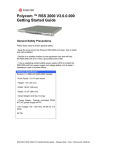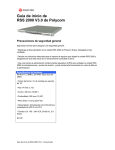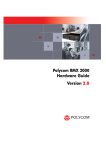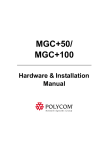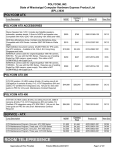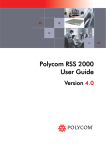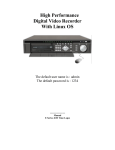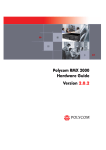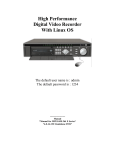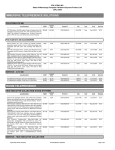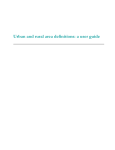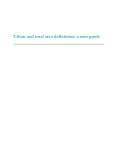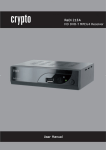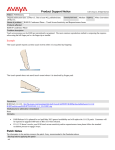Download Polycom RSS 2000 User's Manual
Transcript
Polycom RSS 2000 Getting Started Guide & Release Notes Version 3.0.2 August 2008 DOC2207C Copyright © 2008 Polycom, Inc. All Rights Reserved All text and figures included in this publication are the exclusive property of Polycom, Inc. and may not be copied, reproduced or used in any way without the express written permission of Polycom, Inc. Information in this document is subject to change without notice. This document also contains registered trademarks and service marks that are owned by their respective companies or organizations. If you have any comments or suggestions regarding this document, please send them via e-mail to [email protected]. Catalog No. DOC2207C Version 3.0.2 Notice While reasonable effort was made to ensure that the information in this document was complete and accurate at the time of printing, Polycom, Inc. cannot assure the accuracy of such information. Changes and/or corrections to the information contained in this document may be incorporated into future issues. Portions, aspects and/or features of this product are protected under United States Patent Law in accordance with the claims of United States Patent No: US 6,300,973; US 6,496,216; US 6,757,005; US 6,760,750; and US7,054,820. PATENT PENDING Regulatory Notices United States Federal Communication Commission (FCC) CE & UL Mark Part 15: Class A Statement. This equipment has been tested and found to comply with the limits for a Class A digital device, pursuant to Part 15 of the FCC Rules. Test limits are designed to provide reasonable protection against harmful interference when the equipment is operated in a commercial environment. This equipment generates uses and can radiate radio-frequency energy and, if not installed and used in accordance with the instruction manuals, may cause harmful interference to radio communications. Operation of this equipment in a residential area is likely to cause harmful interference, in which case the user will be required to correct the interference at his or her own expense. Polycom Inc., declares that the Polycom RSS2000 is in conformity with the following relevant harmonized standards: EN 60950-1:2001 EN 55022: 1998+A1:2000+A2:2003 class A UL Listed (USA) CUL Listed (Canada) Following the provisions of the Council Directive 1999/CE on radio and telecommunication terminal equipment and the recognition of its conformity. Compliant with European Battery Directive 2006/66/EC To comply with the European Battery Directive 2006/66/EC, dispose of weak and worn out batteries in accordance with local and national regulations. Table of Contents General Safety Precautions ·····································································1 First Time Installation and Configuration···············································2 Preparations ················································································2 Unpacking and Installing the RSS 2000 ·············································2 Initial RSS 2000 IP Configuration ·····················································2 RSS 2000 Maximum Capacity ··································································6 Network TCP/UDP ports used by RSS 2000 ···········································7 Notes Regarding On Demand Archive····················································8 RSS 2000 V3.0.2 Upgrade Guide ···························································12 New Systems – New Installations ·················································· 12 Existing Systems (Software upgrade only, no new installation) ············ 15 Preparation before Upgrade····················································· 15 Upgrade from 1.0 to 3.0.2 ························································ 16 Upgrade from 2.0 to 3.0.2 ························································ 18 Upgrade from V3.0.0 or V 3.0.1 to V3.0.2 ···································· 20 PHP V5.2.6 Upgrade ··································································· 21 New Feature and Bug Fixes (Compare with V3.0.1) ····························22 RSS 2000 Policies and Limitations ·······················································23 Known Limitations··················································································26 Pending issues ·······················································································28 i Polycom RSS 2000 Getting Started Guide Version 3.0.2 General Safety Precautions General Safety Precautions Follow these rules to ensure general safety: • Keep the area around the Polycom RSS 2000 unit clean, free of clutter and well ventilated. • Decide on a suitable location for the equipment rack that will hold the RSS 2000 unit and is near a grounded power outlet. • Use a regulating uninterruptible power supply (UPS) to protect the RSS 2000 unit from power surges and voltage spikes, and to keep it operating in case of a power failure. Table 1 Hardware Specification Parameter Description Hardware Capability Pentium 4, 2.8Mhz, 2G RAM, 250G Hardisk. Form Factor 1U 19” rack mount Height 1.73” (44 mm) Width 16.83” (430 mm) Depth 15.35” (390 mm) Gross Weight 22.4 lbs (10.2 kg) Power Supply Thermal controlled 220W ATX AC power supply w/PFC AC Voltage 100 - 240 VAC, 60-50 Hz, 5-3 Amps Operation System Windows XPEK OS 1 RSS 2000 Getting Started Guide & Release Notes – Version 3.0.2 First Time Installation and Configuration Preparations Obtain the following information from your network administrator: • RSS 2000 unit, Subnet Mask and Default Gateway IP addresses • Gatekeeper IP address, Prefix, and E.164 of the RSS 2000. Unpacking and Installing the RSS 2000 1 Place the RSS 2000 unit on a stable flat surface in the selected location. 2 To connect to the power source, insert the power cable into the Power connector on the rear panel of the MGC+ unit and insert the Power cable into the power source socket. 3 Connect the LAN cable to LAN1 in the back of the system. 4 Turn on the power switch. Initial RSS 2000 IP Configuration The system is shipped with a default IP configuration: IP Address:192.168.1.254 Subnet Mask: 255.255.255.0 Gateway: 192.168.1.1 There are two ways to change the initial IP address of the sytem: • Via a cross over LAN cable • Via a RS232 or Telnet Console. Changing the initial IP address via a cross over LAN cable 1 Connect a cross over LAN cable to LAN1 in the RSS 2000. 2 Set your laptop to the same segment of the RSS For example (in your laptop IP config setting): 2 First Time Installation and Configuration 3 Open a browser and go to: http://192.168.1.254 4 Login to the system. User name: administrator Password: polycom 3 RSS 2000 Getting Started Guide & Release Notes – Version 3.0.2 5 Go to system configuration->IP setting and modify the IP address. You can set a static IP or choose DHCP. Click the save button and then reset the system. Changing the initial IP address via an RS232 Console or Telnet Another option to modify the IP address of the RSS 2000 is using the RS232 console. Connect to the RS232 port – and activate the console (9600, 8bits) Login: polycom (or any administrator password) When you first login to the console, you will see the current IP address of the system. Help # ? – show all available commands Changing the IP Address # set lan1 static 172.21.100.20 mask 255.255.224.0 [gw 172.21.96.254] Reset Password (back to polycom) A user may reset the password of the administrator to the default of ‘polycom’ # reset password 4 First Time Installation and Configuration • • The same process applies also for Telnet connections. Only one console session can be active at any given time (either Telnet or RS232, not both). The system is now ready for use. For additional configuration instructions, refer to the user guide. 5 RSS 2000 Getting Started Guide & Release Notes – Version 3.0.2 RSS 2000 Maximum Capacity Table 2 Maximum Capacity Scenario Description Maximum Capacity Conference Recording How many conferences can be recorded simultaneously? 2 conference recording links, or 2 endpoints dialing in the same time. Only 1 recording session at a time may utilize H.239. Point to Point recording How many point to point calls can be recorded (if both are dialing into the POLYCOM ™ RSS 2000)? 1 point to point call can be recorded, as the two connections to the recording room utilize both available ports on the RSS 2000. H323 Playback How many recordings can be simultaneously played back in H323? 10 recordings. This includes playback from the local RSS 2000, or from other units in a clustering group. Archive playback (WMV Unicast) How many streams/archives can be simultaneously viewed (unicast)? 50 streams/archives. This is based on the Web Server’s capacity. Archive playback (Multicast) How many streams/archives can be simultaneously viewed (multicast)? 2 streams can be viewed using the RSS 2000 Multicast Viewer. The archives must be enabled for multicast streaming. See the User Guide for details. There is no limitation for the amount of RSS 2000 devices that can be in a single clustering group. 1. In clustering mode, each RSS 2000 still Clustering How many RSS 2000 devices can be clustered in a single group? supports 10 H.323 playback sessions. For example: One H.323 endpoint connects to RSS-A to playback an archive residing on RSS-B (B is in a clustering group with A in this example). The H.323 playback resource it occupies is taken from RSS-A, even though the archive resides on RSS-B. RSS-A has 9 additional H.323 playback sessions available, while RSS-B still has all 10 sessions available. 2. WMV playback via the archive list in the web UI of a clustered RSS 2000 will utilize unicast streaming resources from the RSS device where the archive actually resides, not from the clustered device that the user is connected to. Note this is the reverse of the resource usage behavior for H.323 playback. 6 Network TCP/UDP ports used by RSS 2000 Network TCP/UDP ports used by RSS 2000 Table 3 TCP/UDP ports used by RSS 2000 Usage Type Port Range Manager TCP 81 Web TCP 80 https TCP 443 Trace UDP 30011 Gatekeeper UDP 1719 RAS UDP 1720 Q.931 Socket TCP 1720 H.245 Socket TCP 1730-1739 Live Broadcast TCP 1800-1801 Audio / Video Data UDP 2000-2099 On demand Protocol TCP 554 On Demand Archive TCP (optional) 554 On Demand Archive UDP(optional) Random (for source port) Endpoint/ H.323 Media 7 RSS 2000 Getting Started Guide & Release Notes – Version 3.0.2 Notes Regarding On Demand Archive The UDP ports used for on demand archives are randomly chosen. There are two ways to configure firewalls and Windows Media Player for usage with RSS 2000 on demand archives. 8 1 Open an outbound UDP port range matching what is used by Windows Media Player, or open all UDP ports outbound from RSS 2000 to effectively bypass the firewall for outbound traffic. Also open the port range used by Windows Media Player for inbound traffic to the viewing PC. This range is configurable in Windows Media Player, as seen in Figure 1 (Windows Media Player defaults shown). The user can check RTSP/UDP, check ‘Use ports’ and define the port range. 2 Disable UDP connections in Windows Media Player to force a TCP-only connection. This configuration utilizes only TCP port 554. As seen in Figure 2, unchecking RTSP/UDP removes the user’s ability to specify a port range and forces all connections to use TCP 554 only. Notes Regarding On Demand Archive 9 10 Polycom RSS 2000 Release Notes Version 3.0.2 11 RSS 2000 Getting Started Guide & Release Notes – Version 3.0.2 RSS 2000 V3.0.2 Upgrade Guide New Systems – New Installations For new installations, an activation keycode must be entered before attempting to use the RSS 2000. RSS 2000 V3.x includes two type of activation keys: Table 4 Key Code Definition Package Name Description K-keycode Option Activation (Basic, Multicast, Clustering) U-keycode New Version activation (Will not affect the current installed options) To get K-keycode: 12 1 Log into RSS and go to Product Activation 2 Click Polycom Resource Center , go to the PRC and under product activation: RSS 2000 V3.0.2 Upgrade Guide 3 For a new installation, the system will be shipped with a K License. This will require the user to go to the PRC and receive a K Keycode from the Single License number screen as shown in the screenshots. Do not click ‘Retrieve Software Key Code’ in this step. 4 The user will receive a K Keycode with the enabled options (Basic, Clustering and/or Multicast). Keep this keycode in your records. After entering the K Keycode in the RSS 2000 web UI activation screen, the user will need to go back to the PRC and generate a U Keycode to permit a software upgrade. This is done in the Single Upgrade Key Code page shown below, accessed by clicking the Retrieve Software Key Code button. Users upgrading from version 3.0 or 3.0.1 to version 3.0.2 do not require an upgrade keycode. To get U-keycode: Enter 3.0 in the Version field and enter the RSS 2000 Serial Number in the Serial Number field. The user will receive a U-Key code permitting activation of Version 3.x software. This keycode will also need to be entered in the product activation section on the RSS 2000 Web UI): 13 RSS 2000 Getting Started Guide & Release Notes – Version 3.0.2 After entering both the K Keycode and the U keycode, the RSS 2000 will be ready for use with the enabled options: 14 RSS 2000 V3.0.2 Upgrade Guide Existing Systems (Software upgrade only, no new installation) Preparation before Upgrade Obtain the 3.0.2 upgrade package and activation keys from the Polycom website or your local service center. Save the software and keycodes on your PC (For more details, please see the RSS 2000 Version 3.0.2 User Guide). Table 5 Upgrade package definition Package Name Description RSS 2000.3.0.2 . pkg With full function except PHP V5.2.6 . RSS 2000 PHP V5.2.6. pkg Running base on RSS 2000 V3.0.2 or above version. Table 6 Keycode definition Package Name Description K-keycode Option Activation (Basic, Multicast, Clustering) U-keycode New Version activation (Will not affect the current installed options) • • • For an RSS 2000 running version 1.0, K-keycode and U-keycode are both needed. For an RSS 2000 running version 2.0, only the U-keycode is needed. (The U-keycode permits the upgrade to the new software version, but does not control options activation. For additional options, an appropriate K-Keycode must be purchased). For an RSS 2000 running version 3.0 or 3.0.1, there is no need to perform any activations whatsoever in order to upgrade to version 3.0.2. How to generate keycodes: Please refer to the instructions and screenshots in the New Systems – New Installations section above. • • Before the upgrade, please check the currently installed software version. There is a different process for each upgrade as noted above. Keep the RSS 2000 powered on and connected to the network during the upgrade. 15 RSS 2000 Getting Started Guide & Release Notes – Version 3.0.2 Upgrade from 1.0 to 3.0.2 1 Download upgrade package to RSS a Log in to the RSS and browse to the System Configuration > Upgrade/Reset System page. b Download the “RSS 2000.3.0.2.pkg” to the RSS, wait 10 minutes, then restart the RSS from the web UI. Wait 5 minutes before attempting to log in. For more details on the file download process, please read the RSS 2000 Version 3.0.2 User Guide. 2 Activate RSS Keycode a After rebooting and waiting 5 minutes, log into the RSS and browse to the System Information > Product Activation page. b Paste the U-Keycode and click save. c Paste the K-Keycode and click save. There is no need to restart after entering keycodes. 3 Check the software version and activation status Browse to the System Information > Product Information page 16 RSS 2000 V3.0.2 Upgrade Guide Ensure that the version number, Activation Status, V3.0 Key code activation, and any expected options are properly displayed. (Note on multicast and clustering options: If these options were not purchased, they will not display as activated.) 17 RSS 2000 Getting Started Guide & Release Notes – Version 3.0.2 Upgrade from 2.0 to 3.0.2 1 Download upgrade package to RSS a Log in to the RSS and browse to the System Configuration > Upgrade/Reset System page. b Download the “RSS 2000.3.0.2.pkg” to the RSS, wait 10 minutes, then restart the RSS from the web UI. Wait 5 minutes before attempting to log in. For more details on the file download process, please read the RSS 2000 Version 3.0.2 User Guide. 2 Activate RSS Keycode a After rebooting and waiting 5 minutes, log into the RSS and browse to the System Information > Product Activation page. b Paste the U-Keycode and click save. c Paste the K-Keycode and click save (If you have new option). There is no need to restart after entering keycodes. 3 Check the status Go to System information > Product Information page 18 RSS 2000 V3.0.2 Upgrade Guide Ensure that the version number, Activation Status, V3.0 Key code activation, and any expected options are properly displayed. (Note on multicast and clustering options: If these options were not purchased, they will not display as activated.) 19 RSS 2000 Getting Started Guide & Release Notes – Version 3.0.2 Upgrade from V3.0.0 or V 3.0.1 to V3.0.2 1 Download upgrade package to RSS a Log in to the RSS and browse to the System Configuration > Upgrade/Reset System page. b Download the “RSS 2000.3.0.2.pkg” to the RSS, wait 10 minutes, then restart the RSS from the web UI. Wait 5 minutes before attempting to log in. For more details on the file download process, please read the RSS 2000 Version 3.0.2 User Guide. 2 Check the status Go to System information > Product Information page. Ensure that the version number, Activation Status, V3.0 Key code activation, and any expected options are properly displayed. (Note on multicast and clustering options: If these options were not purchased, they will not display as activated.) 20 RSS 2000 V3.0.2 Upgrade Guide PHP V5.2.6 Upgrade For a new installation, PHP V5.2.6 is embedded, no need to upgrade. For an existing system, please upgrade this system to V3.0.2, then upgrade PHP V5.2.6 version. Download upgrade package to RSS 1 Log in to the RSS and browse to the System Configuration > Upgrade/Reset System page. 2 Download the “RSS 2000 PHP v5.2.6 .pkg” to the RSS, wait 10 minutes, then restart the RSS from the web UI. Wait 5 minutes before attempting to log in. For more details on the file download process, please read the RSS 2000 Version 3.0.2 User Guide. . 21 RSS 2000 Getting Started Guide & Release Notes – Version 3.0.2 New Feature and Bug Fixes (Compare with V3.0.1) 22 Table 7 New Feature and Bug Fixes of Version 3.0.2 # Summary 1 Notes v6.5.x client not able to use the email archive link function of RSSv3.0 2 Multiple Vulnerabilities in PHP 5.2.5 and earlier version, need to upgrade PHP version. 3 Playback has 'fuzzy' audio for the first 30 seconds or so when played back on a PC but not when played back to an endpoint 4 Add a new telnet command to support software shutdown. 5 Resolved integration issue with RMX2000 , the issue is if customer start recording an archive with content from RMX2000 after the endpoint start sending content , customer will get poor video quality . RSS 2000 Policies and Limitations RSS 2000 Policies and Limitations Table 8 Policies and Limitations Subject Description H.323 Alias length The maximum length of the system H.323 alias name is 16 characters. Console Service RS232 configuration: Baud rate 9600, Data bits 8, Parity None, Stop bits 1, Flow control OFF. ONLY ONE connection to the Console service is allowed at any time, either by RS232 or by Telnet, but not both. Endpoint menu When scheduling a dial out & record from the Web UI, RSS will loopback the video and NEVER show the menu unless a menu operation command (FECC arrow keys or DTMF 2/4/6/8) is given from the endpoint. When a pre-defined endpoint dials into the RSS and the endpoint has the "immediate recording" option, RSS will never show the menu unless a menu operation command is given. When inviting an endpoint to a P2P recording room (using E.164 number of the P2P room followed by # or * and E.164 number of the invited endpoint), the inviting endpoint will view menu and the invited endpoint will not view the menu. When two endpoints meet at a P2P recording room, only one of them can view the menu at a time. P2P recording maximum bandwidth Maximum bandwidth for a P2P recording room is 1024K. If video protocol for P2P recording room is H.264, then the maximum bandwidth is 768K. Archive file size If the media file size exceeds 4GB, downloads from Web UI may be incomplete. Media Player Support Windows Media Player 9 or above is required.. RealPlayer can also be used if WMP is properly installed. QuickTime player is not supported. Some third party media player such as Media Player Classic (MPC) and VLC can also be used, but they were not tested and are not supported. Archive playback Archive playback with WMP does not support playback controls: Pause/Resume/FF/Backward, etc H.323 playback During H.323 playback, if there is packet loss and the endpoint requests an I-Frame, RSS cannot honor the request because all audio/video data are from the media file with I-Frames already set. System Reset Hard reset (power off and on) is not recommended. Reset should be done via the Web UI or Console service whenever possible. LDAP integration Only Microsoft Active Directory is supported. 23 RSS 2000 Getting Started Guide & Release Notes – Version 3.0.2 Subject Description H.323 preview Archive Converter When using the RSS 2000ArchiveConverter, the transcoded file loaded back to the RSS will be limited to 20 FPS. Calling with IP address to an RSS that is register with a GK - the call will be rejected. When working with a gatekeeper in routed mode, devices that are trying to call to the RSS using its IP address instead of its E.164 alias will be rejected if they are not registered to the same gatekeeper as the RSS. This is the right policy when working with routed mode on the GK When working with the MGC in Video switching mode – the RSS will indicate High Definition recording is occurring. You can disable HD or define the minimum rate for HD in the single point recording setting of the RSS, or as alternative disable HD in system.cfg of the MGC. MGC Integration HDX Interoperability Playback of H263 recordings by HDX endpoints may result in some video artifacts. 24 Only two H323 devices can utilize archive Preview. This means when there are 2 endpoints previewing on RSS 2000, the third endpoint to connect to RSS 2000 will not receive preview. Even if the two endpoints stop receiving preview or disconnect the third endpoint still cannot receive preview images until it re-connects to the RSS. HD and SD archives cannot be previewed. No Transcoding for Preview. This means that an archive recorded in H263 will not be able to be previewed by an endpoint connected in H264 and vice versa. However, if the endpoint supports both H264 and H263, archive preview will be available. In a clustered configuration, H.323 endpoint cannot receive a preview image of an archive that is not stored on the RSS unit that the endpoint is directly connected to. Only archives with viewing rights configured for “Allow All”, can be shared using clustering. When clustering, archives that are not saved on the RSS 2000 being directly managed, can not be deleted or have their properties modified. Clustering Hunting Each RSS 2000 is capable of 2 recording and 8 H323 playbacks (total of 10 H323 Connections). When using the RSS Hunting function with Cisco GK, the GK will hunt to the next available RSS after the RSS is full with 10 H323 connections. Hunting is only supported with PathNavigator/SE2000, RADVISION GK, and Cisco GK . Streaming without recording cannot pause. When using the Streaming Without Recording function, pause is not available. The stream can only be stopped. V3.0 upgrade V3.0 has 2 separate upgrade packages. The language features can not be included in a single package, part 1 includes all basic functions, and part 2 includes additional languages. Some users will need to upload 2 packages to achieve the required language functionality. For details, please read the version 3 User Guide. RSS 2000 Policies and Limitations Subject Description Image requirement – Languages (except English/Japanese/Chinese) require base image V5.0 . For details, please read the Additional Languages section of this document. IVR support – RSS 2000 version 3 only supports English/Chinese/Japanese IVRs by default. However, the user can manually upload customer IVRs if needed to accommodate local language requirements Multi language support Upload Utility H.263 / H.263+ 4CIF archives can not be uploaded to RSS. HD archives transcode status When moving the mouse cursor over the play button of an archive, if it is an HD archive in the process of WMV conversion, the play button will be in a special status which displays the percentage number of the conversion process completed thus far. The percentage converted will not update until the page is refreshed. 25 RSS 2000 Getting Started Guide & Release Notes – Version 3.0.2 Known Limitations Table 9 Known Limitations Subject Description Overlapping names The monitor screen displays an overlapping names of VSX8000 and RSS in a MGC meeting room VSX 5000-8000 Interoperability The RSS 2000 support the VSX 5000-8000 when the VSX is set to motion (Not Sharpness nor Promotion) RMX 2000 Interoperability The RMX 2000 connects secondary to the RSS 2000 in the rate of 64Kbps (No support for G.728 at the RMX 2000 (RMX 2000 connect to the HDX and VSX at G.729A in 64K which is not supported by the RSS 2000)) – recording at this low video rate is not recommended in any case. RMX 2000 Interoperability While RSS 2000 is connected to RMX2000 in SIF when the RMX is set to Sharpness , an archive of it is tagged as H.264 SD. ViewStation Interoperability ViewStation show blue then green screen at the beginning of a connection to RSS 2000 IVRs When recording an IVR message – it’s require to add additional 1 second of silence for each recording, to prevent message truncation with VSX and Viewstations Maximum frame rate for recording and playback 26 Maximum frame rate for recording and playback in the recording room is 20 fps in H.264 and 25 fps in H.261/H.263 Point to Point recording HD is not supported in Point to Point recording. When using an HD endpoint it’s recommended to dial directly to the recording room [RSS 2000 Prefix][Recording Room Prefix] and not to connect to the Recording room via the H323 Menu. Embedded Multipoint on the VSX When recording a multipoint on a VSX – first connect the endpoint to the VSX and only than connect to the RSS 2000 Sony HG90 version: 2.11 Beta Interoperability Sony HG90 can connect in HD only. The RSS 2000 menu is in CIF (Not in HD) as so the HG 90 will connect as secondary. H239 Content resolution The RSS 2000 support H263 content (Not H264) – as most endpoint currently support H263 content – in order to prevent interoperability issue, when playing back the stream (In H323) the RSS will not support H264 content (Lower common nominator) Econf integration France Telecom eConf can not get video from RSS Aethra X7 integration Connect Aethra X7 to RSS 2000 @1920K ,the X7 sends 720p, but receives CIF from the RSS 2000. RSS 2000 can only support CIF/SIF for menu. RMX 2000 integration HD Recording with the RMX 2000 is supported only on full screen layout. Known Limitations Subject Description 2CIF/2SIF support RSS can not encode 2CIF/2SIF as a standard resolution when transforming to WMV file , the WMV file is not correct resolution , just keep same scale with 2CIF or 2SIF , so the anemographic video will be showed on PC . Disable promotion on the VSX when working with the VSX LAN Setting The same LAN Speed need to be forced on the RSS side and in the switch side. Stereo support SIREN 22 Stereo is supported for H323 Playback. When playing the archive using windows media player - the archive will be played in mono. RSS takes a while to respond to a "stop recording" action at endpoint, can not end and play IVR immediately. RSS 2000 Can not support 2CIF live streaming, will convert to WMV off line. HD Endpoint Embedded MP integration There is a limitation here , if you enable HD capacity of RSS , when it become the first participant to connect HD endpoint with MP , HD endpoint will send HD video format , but once the second endpoint to join the conference , HD endpoint will send CIF format video to RSS , if you start recording before changing to CIF format , it means RSS will save 720P and CIF format video in one WMV file , WMV file can not support this , it will encode error. It is a known limitation. We have 2 option to avoid this : 1 Disable HD capacity of RSS when connect to HD MP 2 After HD MP sending CIF format vide, start to record, before other participants leave (if only leave RSS, will change to HD again) stop recording. I do recommend option 1. FECC control with Endpoint embedded MP When RSS dial into endpoint MP, only when RSS is speaker, customer can control RSS by FECC, but once speaker change to other participant, it will be back never, so customer can not control RSS by FECC. When RSS dial into endpoint MP, if you press left key to hide the menu, you will see the loop video on the screen, so don’t hide the menu in this situation. We recommend when working with endpoint embedded MP, please don’t use FECC control, please just use DTMF. Clustering Only support 10 H.323 playback, including local and remote playback. Software shutdown When use software shutdown command, customer need to turn on the power switch after 2 minutes at least , otherwise the system might not boot correctly . 27 RSS 2000 Getting Started Guide & Release Notes – Version 3.0.2 Pending issues Table 10 28 Pending issues Subject Description FF or REW action within HD archive playback may cause some video artifacts When performing Fast Forward or Rewing when viewing an HD archive using an HDX endpoint, some video artifacts may be observed. Distortion/freezing in converted video using media tool kit After converting an HD archive to H.263 using the media tool kit and uploading the converted file back to the RSS, playback from a ViewStation or VSX endpoint may result in some video artifacts being observed.




































